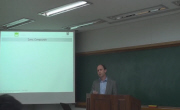Electronic structures and chemical bonding of Li-intercalated LiTiS2 and LiTiO₂ were investigated by using discrete variational Xα method as a first-principles molecular-orbital method. α-NaFeO₂ structure is the equilibrium structure for LiCoO�...
http://chineseinput.net/에서 pinyin(병음)방식으로 중국어를 변환할 수 있습니다.
변환된 중국어를 복사하여 사용하시면 됩니다.
- 中文 을 입력하시려면 zhongwen을 입력하시고 space를누르시면됩니다.
- 北京 을 입력하시려면 beijing을 입력하시고 space를 누르시면 됩니다.
https://www.riss.kr/link?id=A76369388
- 저자
- 발행기관
- 학술지명
- 권호사항
-
발행연도
2009
-
작성언어
Korean
- 주제어
-
등재정보
KCI등재
-
자료형태
학술저널
- 발행기관 URL
-
수록면
8-12(5쪽)
-
KCI 피인용횟수
0
- DOI식별코드
- 제공처
- 소장기관
-
0
상세조회 -
0
다운로드
부가정보
다국어 초록 (Multilingual Abstract)
Electronic structures and chemical bonding of Li-intercalated LiTiS2 and LiTiO₂ were investigated by using discrete variational Xα method as a first-principles molecular-orbital method. α-NaFeO₂ structure is the equilibrium structure for LiCoO₂, which is widely used as a commercial cathode material for lithium secondary battery. The study especially focused on the charge state of Li ions and the magnitude of covalency around Li ions. The average voltage of lithium intercalation was calculated using pseudopotential method and the average intercalation voltage of LiTiO₂ was higher than that of LiTiS2. It can be explained by the differences in Mulliken charge of lithium and the bond overlap population between the intercalated Li ions and anions in LiTiO₂ as well as LiTiS₂. The Mulliken charge, which means the ionicity of Li atom, was approximately 0.12 in LiTiS₂ and the bond overlap population (BOP) indicating the covalency between Ti and S was about 0.339. One the other hands, the Mulliken charge of lithium was about 0.79, which means that Li is fully ionized. The BOP, the covalency between Ti and O, was 0.181 in LiTiO₂. Because of high ionicity of Li and the weak covalency between Ti and the nearest anion, LiTiO₂ has a higher intercalation voltage than that of LiTiS₂.
목차 (Table of Contents)
- Abstract
- 1. 서론
- 2. 계산 방법
- 3. 결과 및 고찰
- 4. 결론
- Abstract
- 1. 서론
- 2. 계산 방법
- 3. 결과 및 고찰
- 4. 결론
- 참고문헌
참고문헌 (Reference)
1 K. Mizushima, 15 : 783-, 1980
2 A. K. Padhi, 145 (145): 1518-, 1998
3 Y. A. Jeon, 17 : 667-, 2006
4 Y. A. Jeon, 2661-, 2006
5 Y. S. Kim, 37 : 6440-, 1998
6 J. V. McCanny, 12 : 3263-, 1979
7 C. Umrigar, 26 : 4935-, 1982
8 W. C. Mackrodt, 142 : 428-, 1999
9 L. Benco, 38 : 20-, 1999
10 M. V. Koudriachova, 86 : 1275-, 2001
1 K. Mizushima, 15 : 783-, 1980
2 A. K. Padhi, 145 (145): 1518-, 1998
3 Y. A. Jeon, 17 : 667-, 2006
4 Y. A. Jeon, 2661-, 2006
5 Y. S. Kim, 37 : 6440-, 1998
6 J. V. McCanny, 12 : 3263-, 1979
7 C. Umrigar, 26 : 4935-, 1982
8 W. C. Mackrodt, 142 : 428-, 1999
9 L. Benco, 38 : 20-, 1999
10 M. V. Koudriachova, 86 : 1275-, 2001
11 A. Lecerf, 7 : 519-, 1962
12 G. Shirance, 12 : 155-, 1960
13 M. V. Koudriachova, 371 : 150-, 2003
14 D. W. Murphy, 19 : 441-, 1982
15 D. W. Murphy, 9 : 413-, 1983
16 G. Kresse, 54 (54): 169-, 1996
17 D. E. Ellis, 58 : 491-, 1976
18 H. Adachi, 45 : 875-, 1978
19 R. S. Mulliken, 1833-, 1955
20 M. K. Aydinal, 56 (56): 1354-, 1997
21 T. Ohzuku, 69 : 201-, 1994
22 C. Masquelier, 135 : 228-, 1998
23 J. B. Goodenough, "Gerneral Concepts in Lithium Ion Batteries - Fundamentals and Performance" Wiley-VCM 1998
동일학술지(권/호) 다른 논문
-
선박용 이종 알루미늄 합금 미그 용접부의 기계적 및 전기화학적 특성 평가
- 한국표면공학회
- 우용빈(Yong-Bin Woo)
- 2009
- KCI등재
-
보철용 지르코니아 어버트먼트의 표면적합도와 전기화학적 거동
- 한국표면공학회
- 박근형(K.H. Park)
- 2009
- KCI등재
-
무전해 도금법을 이용한 코어 셸 구조의 Cu-Ag분말 제조
- 한국표면공학회
- 김종완(Jong-Wan Kim)
- 2009
- KCI등재
-
태양전지 전력을 이용한 316L강의 전해연마 폐액 중 중금속 성분의 회수
- 한국표면공학회
- 김기호(Kiho Kim)
- 2009
- KCI등재
분석정보
인용정보 인용지수 설명보기
학술지 이력
| 연월일 | 이력구분 | 이력상세 | 등재구분 |
|---|---|---|---|
| 2026 | 평가예정 | 재인증평가 신청대상 (재인증) | |
| 2022-01-28 | 학술지명변경 | 외국어명 : Journal of The Korean Institute of Surface Engineering -> Journal of Surface Science and Engineering |  |
| 2020-01-01 | 평가 | 등재학술지 유지 (재인증) |  |
| 2017-01-01 | 평가 | 등재학술지 유지 (계속평가) |  |
| 2013-01-01 | 평가 | 등재 1차 FAIL (등재유지) |  |
| 2010-01-01 | 평가 | 등재학술지 유지 (등재유지) |  |
| 2008-01-01 | 평가 | 등재학술지 유지 (등재유지) |  |
| 2005-01-01 | 평가 | 등재학술지 선정 (등재후보2차) |  |
| 2004-01-01 | 평가 | 등재후보 1차 PASS (등재후보1차) |  |
| 2003-01-01 | 평가 | 등재후보학술지 유지 (등재후보1차) |  |
| 2002-01-01 | 평가 | 등재후보 1차 FAIL (등재후보1차) |  |
| 1999-07-01 | 평가 | 등재후보학술지 선정 (신규평가) |  |
학술지 인용정보
| 기준연도 | WOS-KCI 통합IF(2년) | KCIF(2년) | KCIF(3년) |
|---|---|---|---|
| 2016 | 0.49 | 0.49 | 0.39 |
| KCIF(4년) | KCIF(5년) | 중심성지수(3년) | 즉시성지수 |
| 0.36 | 0.34 | 0.411 | 0.16 |




 ScienceON
ScienceON DBpia
DBpia







